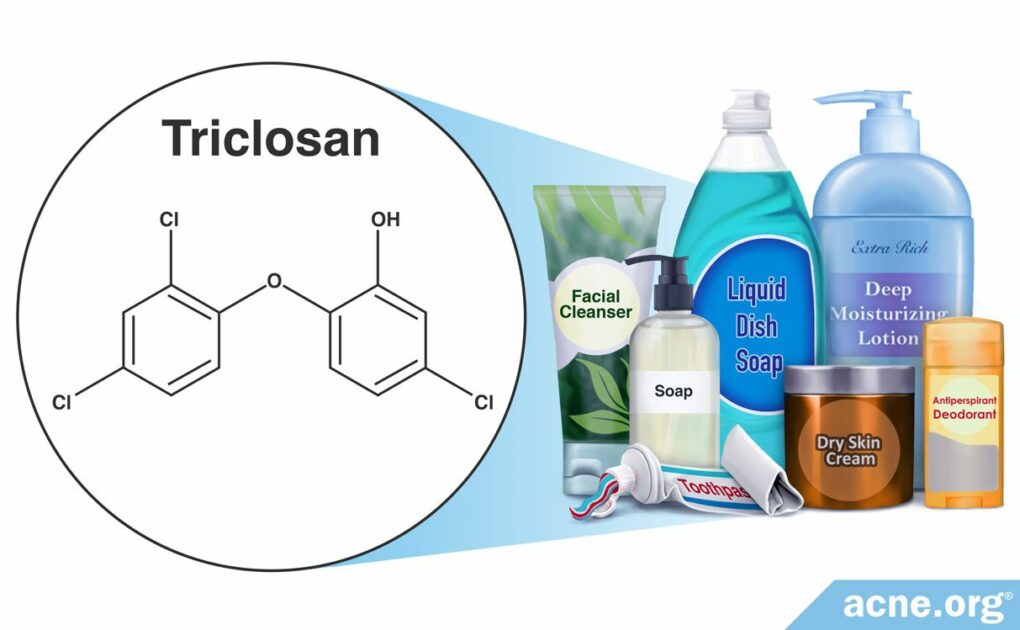Triclosan May Be Useful in the Treatment of Acne, But Concerns Remain

The Essential Info
Most people have heard about triclosan because it is included as the active ingredient in “antibacterial” hand soaps. However, recently the FDA banned the sale of triclosan-containing soaps because they were not shown to be any more effective than regular soap.
But can triclosan help with acne? It may be able to help in 2 ways:
- Antibacterial action: Acne bacteria is responsible for some of the redness and soreness we see in acne lesions. Triclosan can kill or limit the growth of bacteria.
- Anti-inflammatory action: Acne is at its core an inflammatory disease. Triclosan can help tamp down inflammation in the skin.
So why don’t we see it more in acne treatment products? First, because its effectiveness is limited. One study shows that it only reduces acne to a moderate degree. Next, triclosan can lead to resistant strains of bacteria, and resistant bacteria is a major worldwide concern.

The Science
- Uses of Triclosan
- Effectiveness of Triclosan in Treating Acne
- How Triclosan Works to Fight Acne
- Potential Side Effects When Used on the Skin
- Other Concerns About Triclosan
- Conclusion
Triclosan is a man-made chemical that is able to kill bacteria and also inhibit fungus and virus growth.
Uses of Triclosan
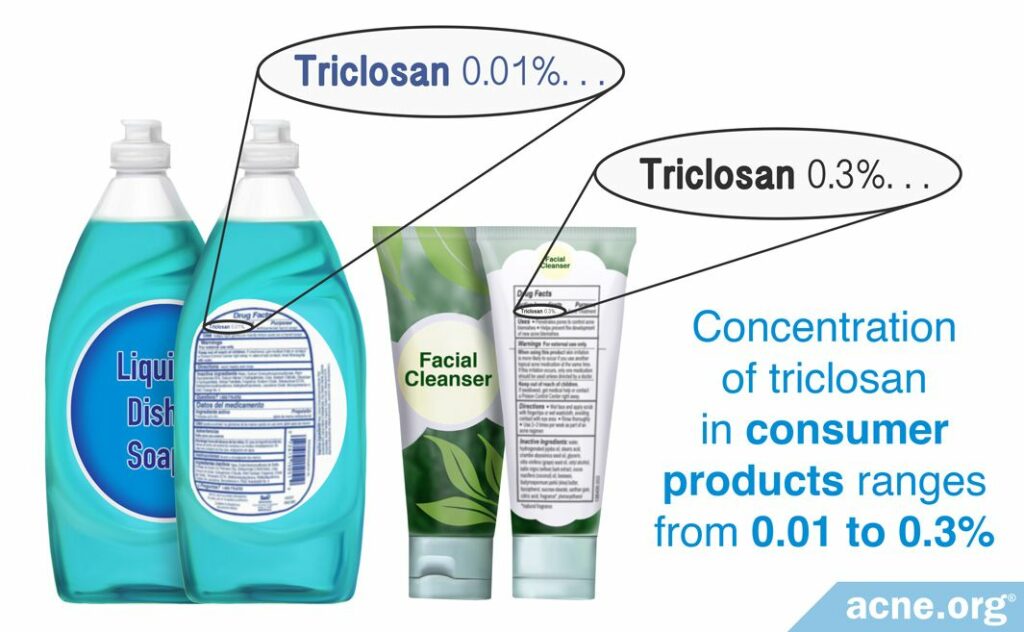
U.S. manufacturers of soaps started using triclosan in the 1970s and its usage has risen dramatically since then. Triclosan is now added to a wide range of consumer products, including soaps, skin cleansers, deodorants, lotions, creams, toothpastes, and dishwashing liquids. It is used at 0.01 to 0.3% strength. Medical professionals also use triclosan on surgical scrubs, medical devices, and dental-hygiene products to control bacterial growth.1-4
Effectiveness of Triclosan in Treating Acne
Some acne treatment products contain triclosan. Acne is at least partly a bacterial disease since most acne lesions are infected with a bacteria called C. acnes. One clinical trial investigated whether triclosan helps clear acne or not and found that it did help to reduce acne to a moderate degree.5
Expand to read details of study
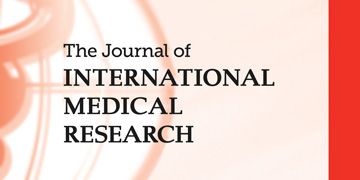
Three groups, with a total of 72 male patients aged 18-22 years, were treated with topical acne-creams for eight weeks. The three groups were treated as follows:
- The first group was treated with a control cream containing no antibacterial compound
- The second group was treated with a triclosan cream
- The third group was treated with a triclosan and propylene phenoxetol (another antibacterial compound) cream
The trial was a double-blind study, meaning that neither the patients nor the doctors administering the treatments knew which group was getting which treatment. A double-blind study minimizes the chance of bias influencing the results.
Researchers evaluated the effectiveness of the formulations by:
- Total lesion-count
- Physician evaluation of the inflammation of lesions
- Self-assessment of the treatment
All 3 methods were performed on each patient. The researchers reported that the control formulation had no effect on the non-inflamed lesions but reduced the number of inflamed lesions by 20%. The formulation with triclosan alone reduced non-inflamed lesions by 22% and inflamed lesions by 44%, a significant reduction. The researchers further reported that the cream containing both antibacterial agents did not significantly increase the effectiveness of the treatment containing triclosan alone, suggesting that triclosan is a reasonable addition to skin products used in the management of mild-to-moderate acne.
The sample size of this study was small, so the results are not conclusive. Only 58 of the 72 patients completed the study, but adverse reactions did not cause any of the dropouts. Only two patients who stayed in the study developed reddening of the skin, which cleared with time.
In addition, some individual case reports and studies based on past medical records suggest that triclosan may be helpful in treating mild forms of a skin disorder called acne inversa.6 This condition, also known as hidradenitis suppurativa, is an inflammatory disorder resulting in lesions and lumps in places like the armpits and groin. Although acne inversa is not the same thing as acne, it shares some similarities with acne. Moreover, some research suggests that people who have acne inversa are more likely to also suffer from acne.7 Therefore, there is a chance that since triclosan helps with acne inversa, it might also improve acne to some degree.
How Triclosan Works to Fight Acne
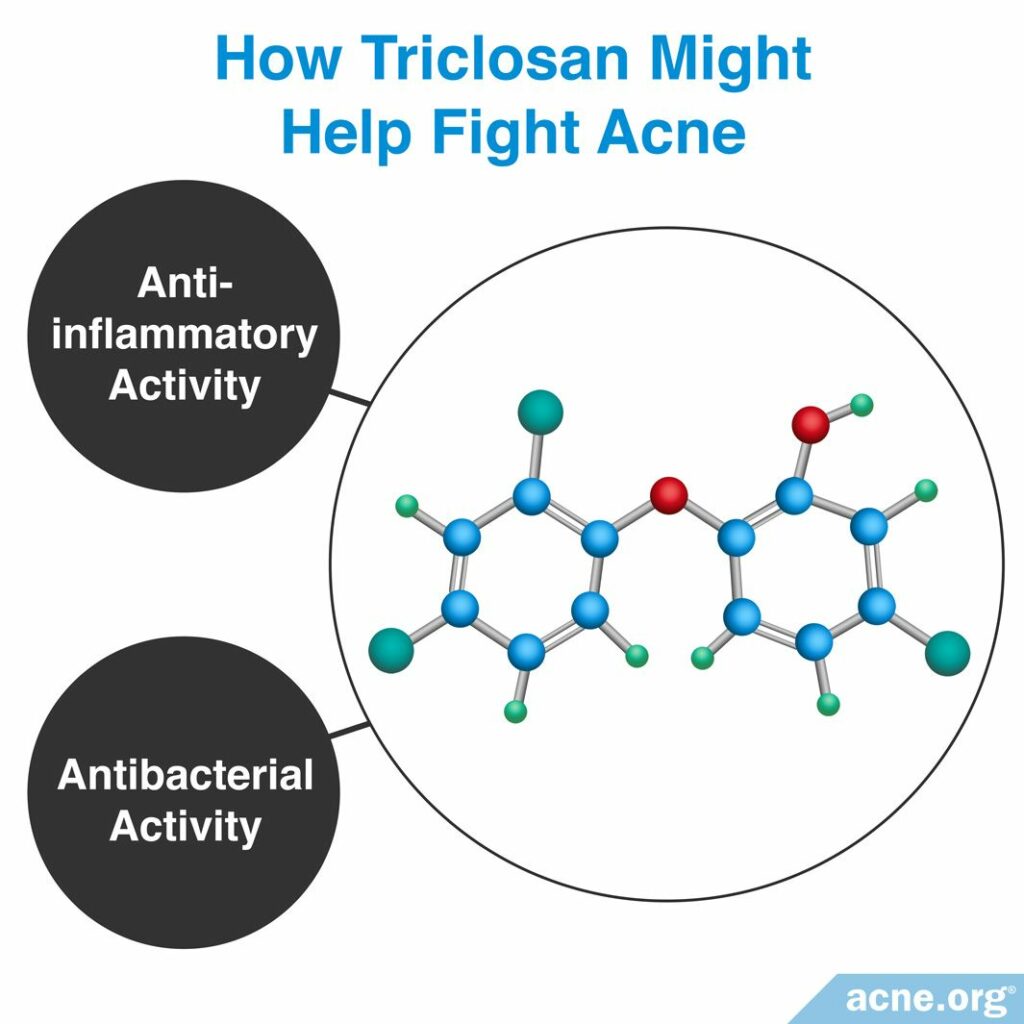
Antibacterial Activity
When used in high concentrations, triclosan is bactericidal, which means it kills bacteria. Exactly how it does this is unknown, but it probably irreparably damages the bacterial-cell membrane, which in turn kills the bacteria. Lab tests have shown that triclosan can kill the acne bacteria C. acnes if the concentration of triclosan is high enough.8 When used in low concentrations, triclosan is also bacteriostatic, which means it prevents bacteria from growing.3 Researchers have not determined the exact concentration that changes triclosan from bacteriostatic to bactericidal action, but suffice it to say that bacteria is not happy when triclosan is around.
Anti-inflammatory Activity
A series of studies shows that triclosan is anti-inflammatory. It reduces inflammation by limiting the skin’s ability to produce a substance that leads to inflammation, called prostaglandins.9 This is important since acne is an inflammatory disease.
Potential Side Effects When Used on the Skin
Manufacturers use triclosan in a wide variety of consumer products. Because of its popularity, researchers have investigated the safety of triclosan in detail.
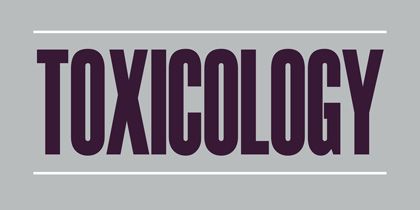
In a 1975 study reported in the journal, Toxicology, a 0.1% triclosan solution was applied daily to the skin of newborn rhesus monkeys. Rhesus monkeys are the genetically the closest mammal to human beings and are often studied to determine how a medication will affect humans. No evidence of toxicity was found in this study. To study the effect of triclosan on humans, researchers applied consumer products containing it to a patch of skin for 24 hours and in some cases repeated for longer periods. These tests showed that the products did not sensitize the skin.9
During other studies on humans, the only adverse reactions to triclosan were rare cases of contact dermatitis after application of a 3% triclosan cream. Consumer products do not contain more than 0.3% triclosan, so they are not likely to cause side effects. In addition, triclosan has not been proven to be harmful to developing fetuses, but research in this area is limited, and pregnant women or women who are trying to become pregnant should always speak with their doctor before using any products with active ingredients.1
Although it is shown to be safe when used in individual products, the European Union Scientific Committee on Consumer Products concluded that the combined exposure to triclosan from all cosmetic products may add up to unsafe levels.3 In other words, it might not be a good idea to use multiple products that contain triclosan.
Other Concerns About Triclosan
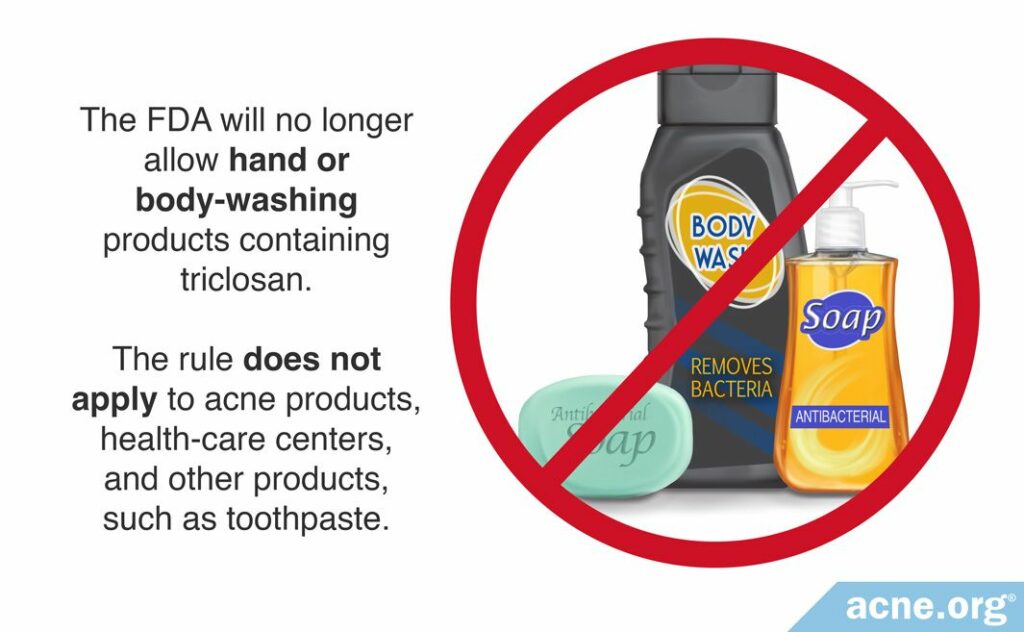
The overuse or misuse of antibacterial agents, such as triclosan, poses the risk of antibiotic resistance. The commonly used concentrations of triclosan are not enough to kill all bacteria, and the surviving bacteria may develop resistance, which can be passed onto future generations of bacteria. Nine studies conducted between 1993 and 1998 reported low levels of bacterial resistance to triclosan, and in one of these reports, the authors stated their concern that widespread use of triclosan in non-healthcare settings will select for bacteria “that are resistant to our dwindling supply of effective antibiotics.”9 Other researchers stated, “(I)t would be wise to restrict the use of triclosan to areas where it has been shown to be effective.”10
The U.S. Food and Drug Administration (FDA) determined that there was not enough evidence to prove that over-the-counter antibacterial soap was more effective in preventing illness than plain soap. The FDA requested data from companies that made these products but received little information. For this reason, the FDA no longer will allow hand-washing and body-washing products containing triclosan to be marketed. The rule does not apply to health-care centers, acne products, and other consumer products, such as toothpaste.11
Conclusion
While unlikely to provide dramatic clearing of acne, triclosan may be useful for the following reasons:
- It inhibits the growth of the bacteria associated with acne
- It reduces inflammation
- One study showed that it was able to help control acne at least to some degree
On the flip side, its widespread use raises the concern of antibiotic resistance. And, since it is less effective than other acne medications at killing bacteria and reducing inflammation, it is rarely formulated into acne products.
References
- Bhargava, H. N. & Leonard, P. A. Triclosan: Applications and safety. Am. J. Infect. Control 24, 209 – 218 (1996). https://www.ncbi.nlm.nih.gov/pubmed/8807001
- CDC. Fourth National Report on Human Exposure to Environmental Chemicals (Fourth Report). (2009). https://www.cdc.gov/exposurereport/index.html
- Davison, J. & Maillard, J. Opinion on triclosan – Antimicrobial resistance. Scientific Committee on Consumer Safety SCCS (2010). https://ec.europa.eu/health/scientific_committees/consumer_safety/docs/sccs_o_023.pdf
- Bergfeld, W. F. et al. Final report triclosan. Cosmet. Ingred. Rev. (2010). https://www.cir-safety.org/sites/default/files/FR569.pdf
- Franz, E. The effectiveness of topical antibacterials in acne : A double-blind clinical study J. Int. Med. Res. 72 – 77 (1978). https://www.ncbi.nlm.nih.gov/pubmed/146628
- Zouboulis, C. C., Bechara, F. G., Dickinson-Blok, J. L. et al. Hidradenitis suppurativa/acne inversa: a practical framework for treatment optimization – systematic review and recommendations from the HS ALLIANCE working group. J. Eur. Acad. Dermatol. Venereol. 33, 19-31 (2019). https://pubmed.ncbi.nlm.nih.gov/30176066/
- Phan, K., Charlton, O. & Smith, S.D. Hidradenitis suppurativa and acne vulgaris and conglobata – systematic review and meta-analysis. Biomed. Dermatol. 3, 12 (2019). https://doi.org/10.1186/s41702-019-0045-z
- Lee, T. W., Kim, J. C. & Hwang, S. J. Hydrogel patches containing triclosan for acne treatment. Eur. J. Pharm. Biopharm. 56, 407-412 (2003). https://pubmed.ncbi.nlm.nih.gov/14602184/
- Jones, R. D., Jampani, H. B., Newman, J. L. & Lee, a S. Triclosan: a review of effectiveness and safety in health care settings. Am. J. Infect. Control 28, 184 – 196 (2000). https://www.ncbi.nlm.nih.gov/pubmed/10760227
- Russell, A. D. Whither triclosan? J. Antimicrob. Chemother. 53, 693 – 695 (2004). https://www.ncbi.nlm.nih.gov/pubmed/15073159
- FDA, U. F. and D. A. Antibacterial Soap ? You Can Skip It – Use Plain Soap and Water. (2016). https://www.fda.gov/consumers/consumer-updates/antibacterial-soap-you-can-skip-it-use-plain-soap-and-water
 Acne.org Products
Acne.org Products